On Dragon Weaving
What I Suppose We'd Call the Preamble
Honestly, I haven't a clue why, in February of last year, I found myself pondering the web of dragon mythology that so ensnares the imagination of man. Of how the machinations of my mind materialized the path it would then travel, I've an even clumsier grasp. I believe there is something significant to be found within the folds of fumbled expression held by the essay I had composed. Now, a year later (finding myself in possession of more diversely and formidably equipped faculties), I shall recompose its art and prose, hoping to attain a composition that more capably communicates that which I have to say. It shall begin with a declaration. It shall end with an appeal. Two waypoints shall lie between the beginning and the ending. With a little luck, journey's end shall bring clarity to the both of us as to how and why the path was chosen.
The Introductory Bit
I find them fascinating, the common threads with which disconnected hubs of humanity weave their native narratives. The similitude with which humanity engineers itself by independent means astounds. It warrants remark, in this digitally polarized age of humanity where tribal gutturals dissemble themselves as discourse, the resemblance that runs through the clutch of reflections caught by the collective looking glass.
Such abstraction, dear reader, may satisfy my selfish need to soliloquize; however, it achieves very little in the way of conceptual connection. We need something concrete, an example exhibiting qualities consistent with the previous prose. What, though? Which player shall I pluck from the troupe?
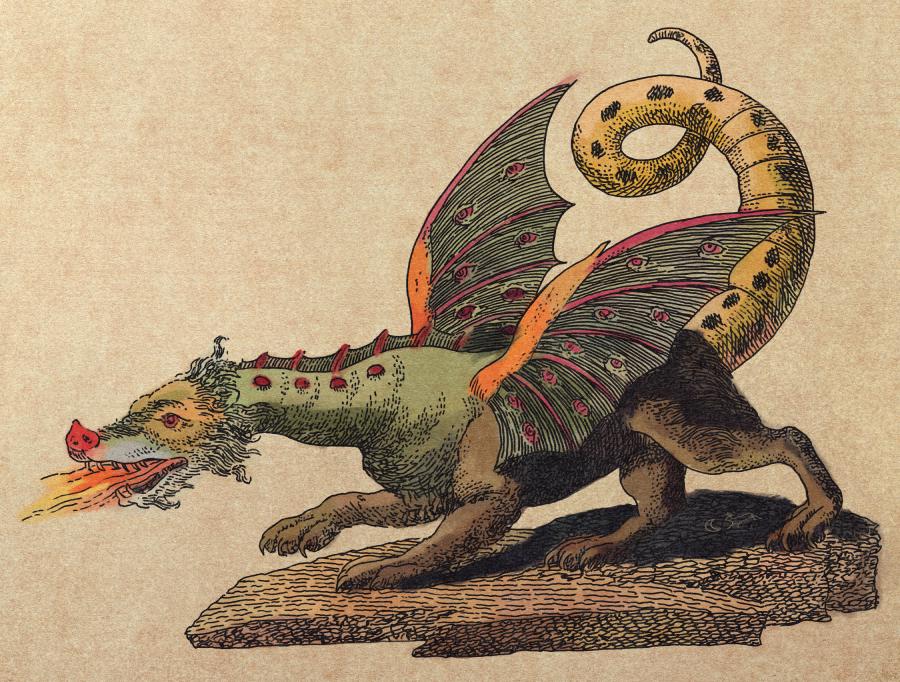
Of course, it's f$&kin' dragons. I named this f$&kin' thing On Dragon Weaving, how the f$&k would I ever work this f$&ker into an essay befitting of the name were I not, inevitably, about to begin talking about dragons? I mean … I name-dropped the little f$&kers in what I believe we've settled upon calling this essay's preamble. Let's hop f$&kin' to it, shall we?
The Bit About Dragons
Sooo, I painted us a subset of dragons arbitrarily selected from the set of humanity's mythoi, two of which you've just seen. Since you're reading this in English (one would assume since I'm writing it in f$&king English), there is a strong chance that global Westernization has narrowed the scope of what you think of as being a dragon. The Game-of-Thronesian1 depiction at the very top likely screams dragon while the fella that follows, the recreation of Bertuch's illustration from the succinctly named Bilderbuch für Kinder: enthaltend eine angenehme Sammlung von Tieren, Pflanzen, Blumen, Früchten, Mineralien, Trachten, induced an assessment of some form or fashion whether he fits the bill. I have no interest in browbeatingly badgering you about what makes a f$&king dragon. I simply thought I oughta point this out and inform you how this essay shall define one. It basically boils down to this: if it's a giant serpent, you can probably get away with calling it a dragon.
I originally began the globetrot in Ancient Egypt; however, taking what I've just relayed into consideration, I think Ancient Greece may be the better initial destination. The reasons are threefold:
⑴ Those for whom the previous passage applies likely received a western education that included at least a little taste of Greek mythology; and, the backbone of Greek mythology is a dragon bone.
⒝ The etymological origin of dragon is the f$&king Greek word drakōn.
(𒄩𒂔𒌈) Some Greek dragons had wings, like the burdened beasts Helios had hauling his chariot about the sky ; but, the majority of the little f$&kers looked more like snakes.
Ancient Indo-European Dragons
Looking like a snake would be totally on-brand for a beastie known to the world as the Lernaean Hydra (which is English for Λερναῖα Ὕδρα) since the word ὕδρα (pronounced hydra) means "water snake" in Greek.
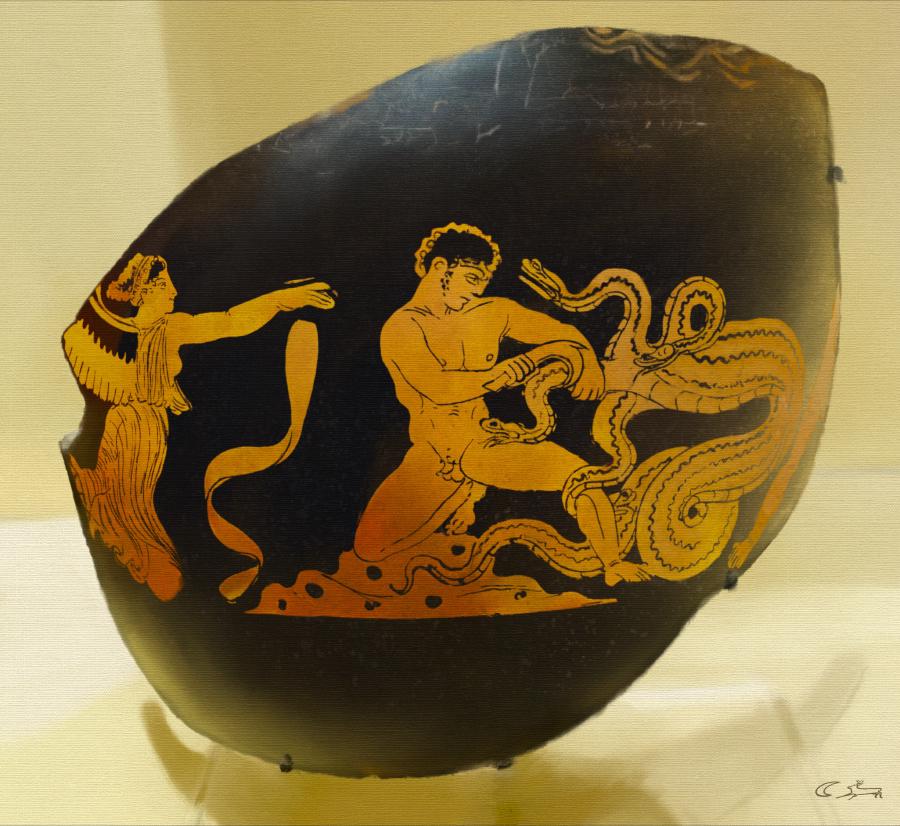
Hera raised this particular hydra for the sole purpose of killing one mighty annoying demigod by the name of Heracles (pronounced Ἡρακλῆς). Buddy's birth-name was actually Alcaeus. Hera sent two serpents to end the boy in his crib. They failed. He'd hoped changing his name to glory of Hera would get her off his ass. It wouldn't. Hesiod's Theogony tells us that the Hydra was the offspring of Typhon and Echidna, two badass MFers, living in the lake of Lerna in the Argolid.
With multiple heads (one of which was immortal … all of which would grow back), poisonous breath, and blood so corrosive it could kill with a whiff, the Hydra was f$&kin' fierce. King Eurystheus gave Heracles the task of slaying this sucker as his second labor (during his post-murdered-my-wife-and-children atonement tour). They battle. Heracles wins. Yada yada yada, let's move on, I'm bored.
The kētŏs or κῆτος (latinized as cetus) I have to show you appears to exhibit a few more of the physical traits we might expect from a western dragon (I mean … compared to a snake).

The depicted mosaic was discovered in the floor of an ancient Kaulonian residence now referred to as the House of the Dragon. His attack position pose would suggest that this little fella served as the last line of defense against malevolent forces for the adjacent banquet's airy ambience. The Museo archeologico dell'Antica Kaulon, the mosaic's current home, describes the discovery as, "a polychrome mosaic depicting a sea dragon and … framed by a pattern formed by sea waves."
Let's review. The Lernaean Hydra looked like Hera tied herself a handful of water snakes in an overhand knot, like they were auditioning to play opposite of that little, problematically portrayed Japanese Beetle in an episode of The Blue Racer. The Cetus, by comparison, looks all kinds of dragonish. The museum calls him a sea dragon and his place of birth the House of the Dragon. What about a creature whose name f$&king ends with Dragon?
Meet the Colchian Dragon (Δρακων Κολχικος), guardian of the Golden Fleece until Jason and his merry band of Argonauts came calling.
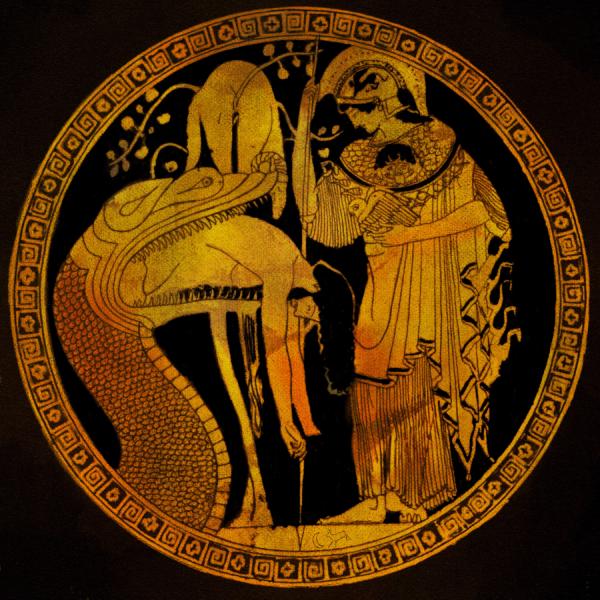
So … yeah … he looks like a f$&king snake. Like I said, if it's a giant serpent, you can probably get away with calling it a dragon. They are all dragons. Just go with it.
Afro-Asiatic Dragons
Leaving Ancient Greece in the rearview, we'll now drop our bucket deep down within the well of humanity to probe Terrestrian time before the Biblical flood. Like Johnny Cash, we're going to Memphis, in Ancient Egypt, to have us a look-see at Apep (pronounced 𓌇𓊪𓊪𓆙).

Mention of this particular deity began appearing early in the 22nd century BCE as the sun was setting upon the authority of the Old Kingdom. As chaos incarnate, oppugnant to order and light, no doubt Apep was frequently sighted walking in Memphis near the collapse of the Eighth Dynasty. And get this, when Isis, Set, and Ra jacked Apep (as part of their Egyptian power grab), tossing him into the underworld … Apep was having none of it. Every morning thereafter he'd make his way back to the horizon, ahead of Ra, and force that f$&ker to defeat him in battle just to put the sun in the sky. And in the event of a solar eclipse … an eclipse meant that Apep managed to swallow that f$&ker … the sun returning to the sky only after Ra's companion gods manage to topple Apep and cut open his stomach.
Before we exoduse ourselves out of Egypt, we simply must allow ourselves a proper peep at the world's most interminable orbiculate ophidian, Ouroboros.
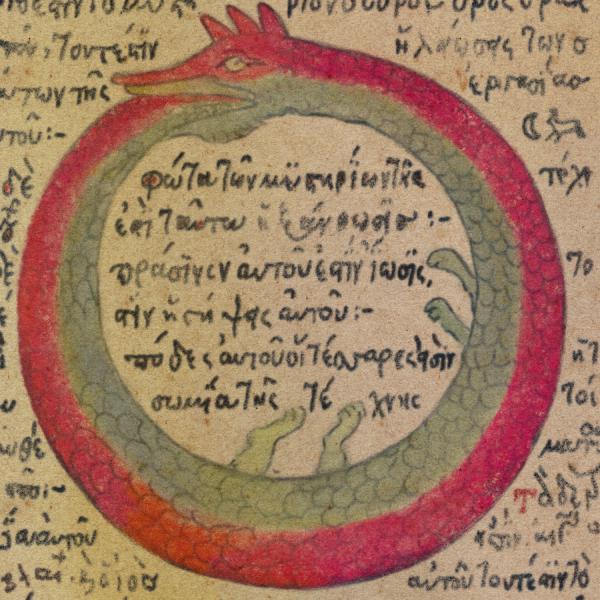
A manifestation of the snake god Mehen, Ouroboros may be found inscribed upon the shrine of a sarcophagus as part of the Enigmatic Book of the Netherworld where he represents the beginning and the end of time.
Drawings of Ouroboros would later begin popping up in early alchemical texts like that of Cleopatra the Alchemist, whose work The Chrysopoeia of Cleopatra contains an illustration (not pictured) of the serpent along with the words ἓν τὸ πᾶν (the all is one). The inside of my left leg happens to have this very same illustration (also not pictured) just above the ankle.
Chuck yourself a dart at any wall-hung world map and chances are you'll strike land where Ouroboros dwells. In Norse mythology, exempli gratia (the WordHippoist's for example), he appears as Jörmungandr, the World Serpent—who would grow so large he could encircle the world, grasping his tail in his teeth. Come Ragnarok, it is the poisonous breath of the Midgard Wyrm that kills the mighty Thor.
Middle Aged Indo-European Dragons
Germanic myth, Norse inclusive, is simply dripping with dragons. Just look at the Vikings … I mean … they sailed f$&king drakkar.
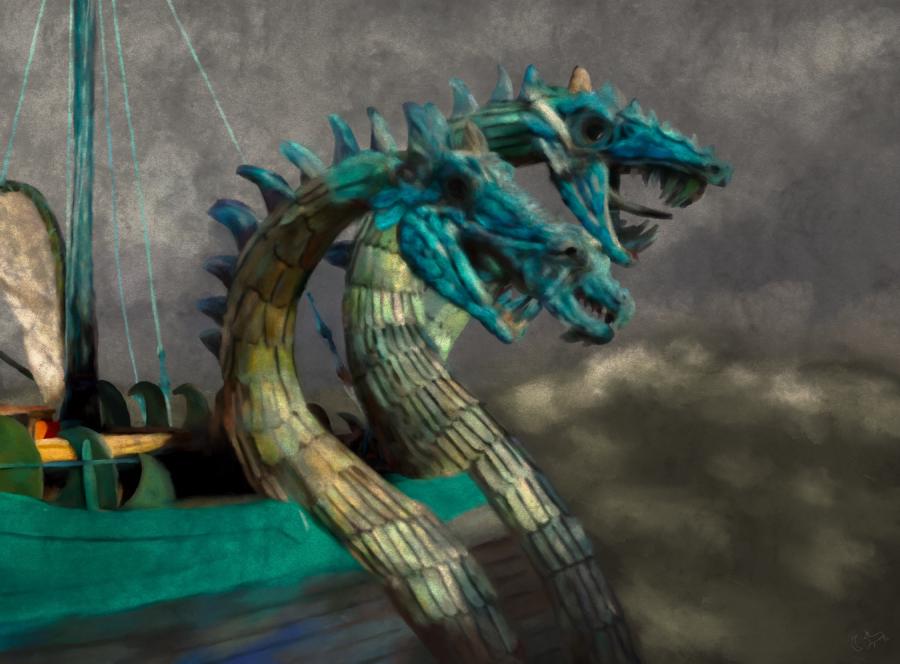
The dragonhead(s) carved into the stem of these large longships were said to offer protection from evil spirits while at sea. Such power did these wooden drakes possess that Icelandic code of the time, Grágás, bade the Vikings remove any such dragonhead upon their return so as not to intimidate the spirits of their native land.
The three carved heads on the ship above identify the bow-based bulwark as a dragon named Zmey Gorynych, let's gallantly gallivant into Garðaríki for a formal introduction.

Garðaríki, by the way, is Old Norse for Kievan Rus'. The Garðar were the Rus' people, Norsemen that had decided to pop on over and take up ruling the river routes between the Baltic and the Black Seas. You zmey have deduced from all those f$&king letter 'Y's, we've crossed over the Germanian border into Russian folklore territory.
Zmey was all about the bylina (Russian heroic poetry). Totally tracks that he would frequently transform himself into a handsome youth to engage in the art of seduction.
Don't let his pervish proclivities prevaricate (yeeesss … I f$&king see the problem … but WordHippo sticks that sh$t in my head … and I can avoid alliteration like Murphy can avoid running head first into a thumpish engagment with the thick, full-length windows that monopolize wall space around here when she's so f$&king excited she can take no more).
Zmey is a proper red-scaled, fire-breathing western dragon with blood so poisonous the Earth itself will refuse to absorb it. This little f$&ker would even go all eclipsical from time to time by taking a bite out of the f$&king sun.
A dark age development, the western dragon is typically depicted as large, fire-breathing, scaly, horned, four-legged, bat-winged and in possession of a long, muscular prehensile tail handy for curling up cozily inside its underground lair. Between the eleventh and thirteenth centuries, that dragons were living, fire-breathing creatures was common f$&kin' knowledge.
The first known portrayal of the fully modern, western dragon appears in a medieval manuscript circa 1260ish.
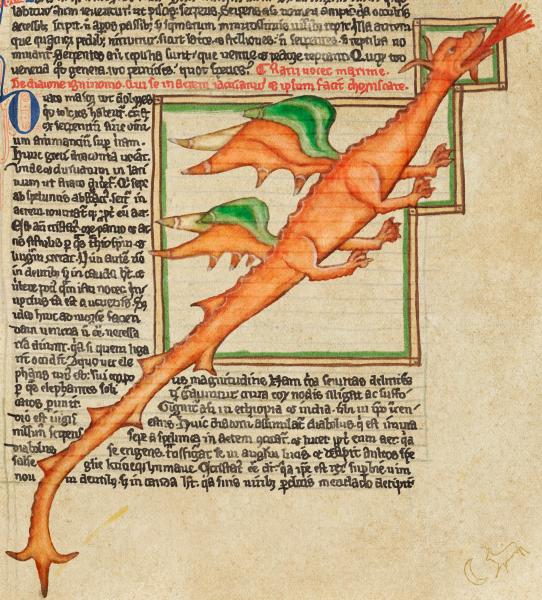
This little f$&ker is the kind of dragon that most of you were probably picturing upon first taking it upon yourself to read this … this what? … whatever the f$&k it is you want to call this thing you're reading now … like right now … like your eyes line up with this blinkity f$&king cursor now … like *slap* *brief pause* *blinky eyed head shake* … what say we head east and have a look at what the rest of you were picturing.
Sino-Tibetan Dragons
While the Western dragon roots itself to the hero-versus-giant-serpent motif of Proto-Indo-European mythology, it is the Chinese dragon that is birthed by Proto-Sino-Tibetan mythology. From what I've gathered after a seriously soft amount of internet research, the linguistic trip taken by the Western dragon from the Proto-Indo-European word *derḱ- to the Modern English word dragon has a parallel in that taken by the Chinese dragon from the Proto-Sino-Tibetan word *rŏŋ to the Modern Chinese word lóng (pronounced 龙 … or possibly 龍).
The dragon's permeation of East Asian culture is next level. The legendary Chinese sovereign, Huangdi, was said to have taken the form of the Yellow Dragon to ascend to heaven. As the Yellow Emperor is seen as an ancestor of all Chinese people, they sometimes refer to themselves as children of the dragon. In Chinese popular religion, the Yellow Dragon would become one of the five deities composing the fivefold manifestation of the supreme God of Heaven.
Another of the five, the Azure Dragon, would find himself depicted on what would become China's first national flag, that of the last imperial dynasty, the Qing.
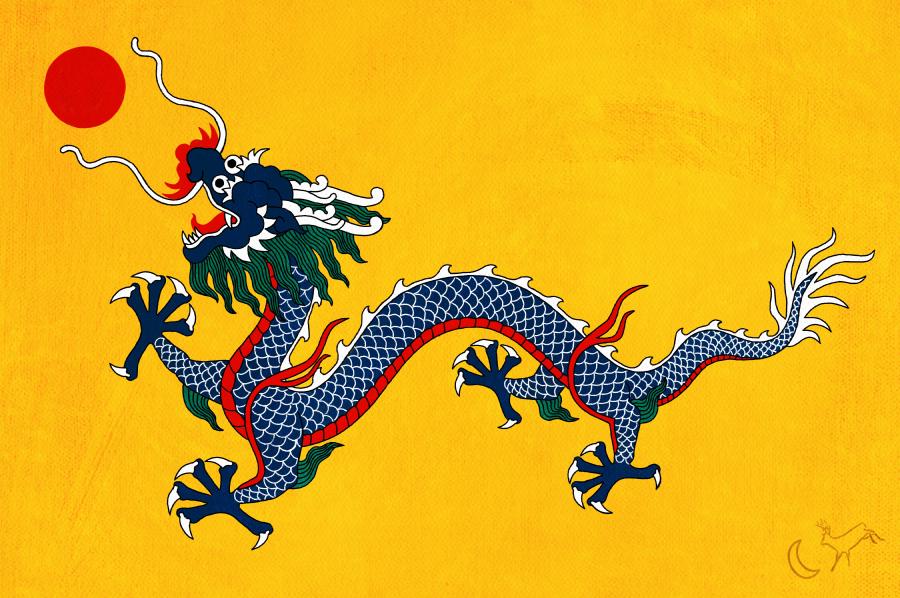
Traditional Chinese architecture calls for the erection of a spirit screen, or screen wall, for keeping out evil spirits. Take this concept, toss in a dragon motif, multiply ninefold, imperialize it, and you've got yourself a Nine-Dragon Wall perfect for placing in one of the imperial gardens or palaces you happen to steward.
The dragons battling it out below over the flaming pearl depict two-sevenths of the Nine-Dragon Wall found in the Beijing-based former imperial garden, Beihai Park.

The prickly pair have good reason to covet this fiery little orb. These little treasures are guaranteed to be holding some high-value commodity—wisdom, power or prosperity, perhaps. Maybe something tangible like thunder or the moon. If it's top shelf, the pearl may embody immortality or even the universal Qi, progenitor of all energy and creation.
As the Indo-European mythologies would emerge, so would the Sinon-Tibetan. Take one part Chinese dragon, one part native legend, stick the parts together, and you'll have yourself a Japanese dragon not unlike the one Hokusai painted onto the ceiling of the Higashmachi festival float in 1844.

It's the three toes on the feet of this handsome fella, along with his slender serpentine physique, that give his origin away. As it happens, the number of toes kinda became a thing. During the Zhou dynasty, this number came to represent rank, therefore most Chinese dragons you come across are gonna have a full five toes. The working theory in Japan, however, was that all dragons were of native origin with three toes per foot. If a dragon wants to leave Japan, it can expect to sprout some toes. The greater its distance from Japan, the more appendages it shall acquire. The toe count gets capped at five when a dragon reaches China.
Operating under this logic, it totally fits that Korea would be chock-full of four-toed dragons like the Blue Dragon in the Koguryoan mural.

Of course, the Koreans believed the four toes on their dragons clearly demonstrated their superiority to the three-toed dragons of Japan. It's that fourth toe that enables the dragon to clutch those pearls. Note that there are four-toed Chinese dragons. When dragon watching, observe the beard. Korean dragons tend to have long ass beards.
Let's keep heading east, I really want to look at some dragons with whom the descendents of Paleoamerican cultures would become acquainted.
Algic and Uto-Aztecan Dragons
Dragons flourished all across the pre-Columbian Americas; however, getting to know them is a f$&king challenge. Genocide and forced assimilation kinda tend to disappear the afflicted culture. Consider the case of the Piasa Bird found in Alton, Illinois.
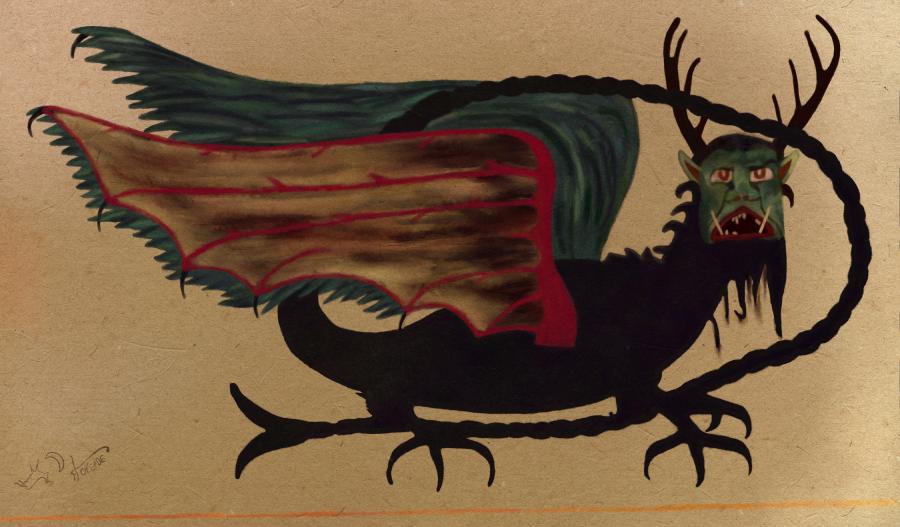
A pair of these suckers were absof$&kinlutely painted upon the limestone bluffs above the confluence of the Illinois and Mississippi rivers. How do we know? A Frenchman told us what he saw during his 1673 expedition of the Mississippi River. As to what he said, here's the valuable bit:
They are as large as a calf; they have horns on their heads like those of deer, a horrible look, red eyes, a beard like a tiger's, a face somewhat like a man's, a body covered with scales, and so long a tail that it winds all around the body, passing above the head and going back between the legs, ending in a fish's tail. Green, red, and black are the three colors composing the picture.
The 1917 publication from which I've pulled his account also includes a helpful little footnote. See if you can spot the problem:
These pictographs on a rock near Alton, Illinois, were called "piasa" and supposed to represent the "thunder bird." They were quite distinct when described by Stoddard in 1803; when visited in 1838 only one could be seen, of which traces were discernible as late as 1848, soon after which the rock was quarried down.
I mean…
⒜ The account from 1673 doesn't say sh$t about what these things are called.
⑵ The footnote from the publication doesn't say sh$t about who mentioned the things oughta be called piasa.
(ᓭ) They quarried … the fucking … rock.
Before moving on from Marquette's account, I wanna show you the least valuable bit. Picking up where we left off in that first quote:
Moreover, these two monsters are so well painted that we cannot believe that any savage is their author; for good painters in France would find it difficult to paint so well, and besides, they are so high up on the rock that it is difficult to reach that place conveniently to paint them.
I believe the Illini response to this was something like ᐃᒃᓯᕚᕐᓂᖅ ᕿᒥᕐᓗ (pronounced sit and spin).
It gets better.
The painting I recreated is by Herbert Forcade. He made it in preparation for painting the f$&ker back up on that limestone bluff. In 1924, he totally did. In the 1960s, they totally blasted that shit to make way for the Great River Road.
It gets better still.
Curious how the Piasa Bird got its name? Let me tell you. In 1836, local Professor John Russell of Shurtleff College published an article with the deets he claims to have obtained from the Illini. Of the stream below the bluff, he has this to say:
This stream is the Piasa. Its name is Indian, and signifies, in the Illini, 'The bird which devours men.' Near the mouth of this stream, on the smooth and perpendicular face of the bluff, at an elevation which no human can reach, is cut the figure of an enormous bird, with its wings extended. The animal which the figure represents was called by the Indians the Piasa. From this is derived the name of the stream.
Okay, so far, we have a real portrayal of a Native American dragon … given to us by a small-minded Frenchman. We add to this the naming of the thing some one hundred sixty-three years later by a professor from a Baptist college (further confirmed in the footnotes of a book published some seventy-six years after the prof's article). What we seem to be missing is some authentic Illini legend of this creature. Have we one of those?
As it happens, we do have one of those, provided in the very same article that gave us the beast's name. Search the internet for the bird's backstory, and you'll find the Legend of the Piasa Bird repeated in countless places. Why haven't I told you the legend? 'Cause the f$&ker admitted he made the whole thing up. You've got about a 50/50 shot of being told that alongside any given one of those repetitions.
Can you believe the dragon exhibition was originally gonna end here? Exploring the erasure of a people's origin story from the annals of history kinda pulled us off course, so I thought it best to square things up by painting one more to pull us back. I then constructed a segue that must make the gods of grammar and style weep (and not in a good way). Easily surpassing the forty word mark utilized by Ulysses to trigger sentence splitting suggestions for me to ignore, this beast also happens to count among its possessions three commas, two dashes, a colon, a pair of parentheses, and my approval (so, I'm keeping it). Allow a little extra time for its digestion. I'm sure it'll be fine.
From a dragon mythologized and then quarried by the white man, as if it weren't but hillbilly graffiti—sold twice for a profit, first as so many slabs of limestone and next as an attraction by the city of Alton—before being appropriated by Southwestern High School (home of the Piasa Birds and a standalone replica that spits f$&kin' fire), to a dragon colonialism would not erase: we're heading south to see Quetzalcōātl.
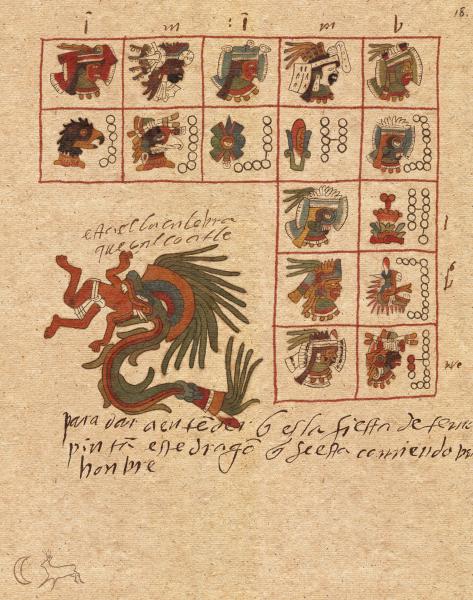
The name Quetzalcōātl is a composition of two Nahuatl language words: quetzal or beautiful feather and coatl or serpent. This fella lay at the end of the mesoamerican feathered serpent's evolutionary timeline. By the time his likeness was being drawn into pages, he had a pyramid dedicated to his worship—the world's largest pyramid. We can probably blame the Toltecs for his naughty noms. They linked war and human sacrifice with celestial bodies. They also anointed Quetzalcōātl the god of the morning and evening star.
The Aztecs maintained his solar deification, along with the death and rebirth associations that came with the position. They did manage to round him out a bit by anointing him the god of learning, science, crafts, arts, and agriculture. Oh, he also created humanity in this fifth cycle of the sun we're currently living through.
How can we know all this about Quetzalcōātl yet remain so ignorant about the Piasa Bird? His stone wasn't quarried. His story, written by native Nahuatl speakers, has been preserved. Moctezuma had himself a f$&kin' library. What I've recreated up there is a page from the divinatory almanac included in the amatl known as the Codex Telleriano-Remensis. Shown on the page are the 14th trecena, Quetzalcōātl, and some gloss that explains his significance.
Towards the Making of a Point
So, why have I shown you all these dragons? Presumably, I did so to support the flowery language from the introductory bit poetically waxing the common threads running through narratives woven independently. Maybe I went through all that dragon mythology to draw out common motifs—motifs such as the tendency of a dragon to control the weather, to rule the water, or to temporarily block out the sun–perhaps, touch on the possibility of shared catalysts such as unearthed dinosaur bones, large reptiles, or the compulsion to explain natural phenomena.
This may have been my intent when I began typedly exploring the thought in February of last year. I can't be certain, as the memory has frayed, its clarity now lost. I haven't the faintest how other writers go about their business, if they know already the shape of the thing they intend to create. Me, I never know where I'm going. I write like I'm transcribing a thought experiment in progress. I freeze in amber some rumination, then reflect on its implications. Reflection spawns the next item to be resined or the dishes are done, man.
I am almost certain that it was writing in this manner that caused my focal point to drift. Reflecting on the commonalities immediately drew my attention to the discrepancies. Reflecting on the duality, I found that each side held value—so I considered them both. I shall now do so again, perhaps with a bit more care, and with the benefit, this time, of knowing where I want to go.
Some Woven Dragons
My mind gleans meaning via metaphorical odyssey. This particular expedition's point of origin practically presents itself. Threads are but thin yarns, after all, and what are myths if not stories? Let us explore the storyteller and the threads of thought with which his yarn is spun.
Consider this, a picture tells a thousand stories while it also tells its own. Stories are recursive constructs. A picture digitally displayed encodes these stories within its pixels. A picture printed to paper encodes these stories within the pigments of its ink. A picture woven as a tapestry encodes these stories within its threads.
The storyteller spins a yarn for transmitting select information as a recognizable pattern from which meaning may be gleaned. The raconteur, with his hanks of yarn, is a weaver—carefully crossing threads until a tapestry takes shape that tells a thousand stories. There are many such tapestries to be found in our histories whose shape is that of a dragon. I've painted two of them for us to examine and see what we find in their threads.
Some Apocalyptic Threads
First, we'll look at the recursive story composition woven into a portion of the twelfth panel of the third Apocalypse Tapestry, conceptualized by Flemish painter Hennequin of Bruges and constructed inside the Parisian workshops of Nicholas Bataille.
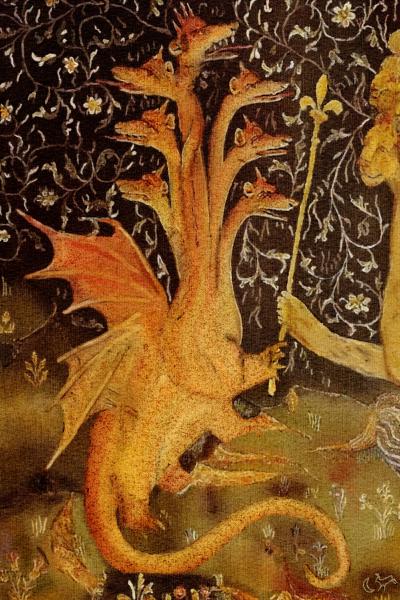
I suppose we should briefly go over what I mean by recursion before I continue. That this first example is actually a portion of a fourteen panel tapestry kinda plays into the whole recursive composition concept. Clearly, each panel tells a story. The tapestry in its entirety also tells a story. It's a story within which each panel's story happens to be embedded. A story made of stories. This, for those of y'all without a background in mathematics or computer science, is recursion in a nutshell.
Within each panel, the weaver tells a story, perhaps more than one. It's important to understand that the recursion does not necessarily, in fact, it's unlikely to, end with these stories. Short of the telling of a story fabricated entirely within the mind of a weaver that had managed to master textiles whilst whiling away on the deserted island upon which they'd washed up as a baby to be raised by some language-less species, the story told by the weaver incorporates stories that predate the tapestry's creation. If you aren't quite sure what I mean, I think you will be once we've dug in a bit. Time for some story extraction.
We needn't know the tapestry's origin, medieval France, to surmise that what stands before us (with a weird little buddy) is a western dragon. If you look past the head and wing count, he kinda looks like the dragon from that medieval manuscript. Had I shown you all eight of the panels from this tapestry in which our fella makes an appearance, many of the Indo-European dragon motifs would catch your eye, most notably the dragon's mastery over water, his harassment of a maiden (whose baby he wants to devour), and a bout with spear hero. How many stories, by the year 1375, must lay in the lineage of the western dragon?
Here's where it gets interesting, we've barely scratched the surface–for the majority of this tapestry was woven with yarn spun by John while in exile on the Greek island of Patmos2. He was all:
12:3 καὶ ὤφθη ἄλλο σημεῖον ἐν τῷ οὐρανῷ, καὶ ἰδοὺ δράκων πυρρὸς μέγας, ἔχων κεφαλὰς ἑπτὰ καὶ κέρατα δέκα καὶ ἐπὶ τὰς κεφαλὰς αὐτοῦ ἑπτὰ διαδήματα,
12:4 καὶ ἡ οὐρὰ αὐτοῦ σύρει τὸ τρίτον τῶν ἀστέρων τοῦ οὐρανοῦ καὶ ἔβαλεν αὐτοὺς εἰς τὴν γῆν. καὶ ὁ δράκων ἕστηκεν ἐνώπιον τῆς γυναικὸς τῆς μελλούσης τεκεῖν, ἵνα ὅταν τέκῃ τὸ τέκνον αὐτῆς καταφάγῃ.
You may (or may not) be familiar with John's story. Were he translated into English, he'd be all:
12:3 And another sign was seen in heaven, and behold, a great red dragon, having seven heads and ten horns, and on his heads seven crowns,
12:4 and his tail is pulling one third of the stars from heaven; and it threw them to the earth. And the dragon took his stand in front of the woman who was about to deliver, so that he might devour the child whenever it was born.
So, yeah, this isn't just any old dragon. This is that apocalypse. Those were passages from ΑΠΟΚΑΛΥΨΙΣ ΙΩΑΝΝΟΥ (pronounced The Revelation of John (and that's a wrap on pronunciation jokes)). This is f$&kin' Satan, as John lets us know a few passages later:
12:9 καὶ ἐβλήθη ὁ δράκων ὁ μέγας, ὁ ὄφις ὁ ἀρχαῖος, ὁ καλούμενος Διάβολος καὶ ὁ Σατανᾶς, ὁ πλανῶν τὴν οἰκουμένην ὅλην – ἐβλήθη εἰς τὴν γῆν, καὶ οἱ ἄγγελοι αὐτοῦ μετ’ αὐτοῦ ἐβλήθησαν.
Translated here into another run-on sentence (see … my writing style ain't faux-pas-matic … it's f$&kin' biblical):
12:9 And the great dragon was thrown out, that ancient serpent, which is called the Devil and Satan, who deceives the whole world, he was thrown to the earth, and his angels thrown along with him.
The fella on the right is some bearionard John just calls beast. Our dragon, here, happens to be passing along his power (which I guess he keeps in a scepter ¯\_(ツ)_/¯). I better just let John explain:
13:2 καὶ τὸ θηρίον ὃ εἶδον ἦν ὅμοιον παρδάλει, καὶ οἱ πόδες αὐτοῦ ὡς ἄρκου, καὶ τὸ στόμα αὐτοῦ ὡς στόμα λέοντος. καὶ ἔδωκεν αὐτῷ ὁ δράκων τὴν δύναμιν αὐτοῦ καὶ τὸν θρόνον αὐτοῦ καὶ ἐξουσίαν μεγάλην.
Which not a one of you are gonna f$&kin' understand, so here's a guy explaining what John explained:
13:2 And the beast which I saw was like a leopard, and the feet of it like a bear's, and his mouth like the mouth of a lion. And the dragon gave his power to him, and his throne, and great authority.
Having sufficiently covered the whole stories-made-of-stories angle and drawn out the more interesting bits of this particular great red dragon's story (browbeating y'all with ancient Greek I sure as shit can't read along the way). Let's move on to the kesi (silk tapestry) I painted.
Some Benevolent Threads
Woven two hundred years later, give or take, on another continent entirely, this happy little fella likely hung about upon an altar as part of a ceremonial arrangement.
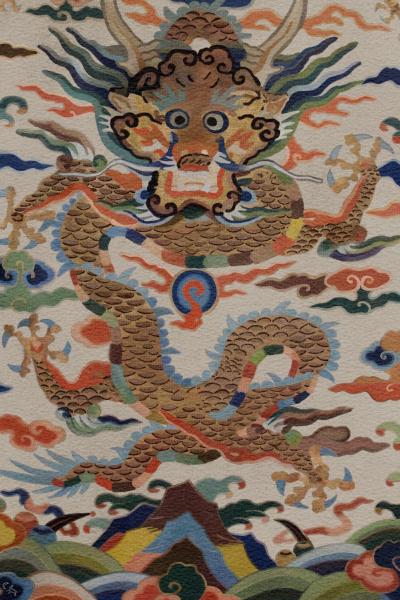
The museum that restored this particular tapestry says it was originally part of a larger hanging. I am entirely ignorant as to the contents of the accompanying panels. Seeing as I've already made my point about recursive composition, I think we're fine with what we've got.
Just as western dragons carry their Indo-European roots, Chinese dragons carry their Sino-Tibetan roots. This little cutie likely landed his gig on account of his standup delivery of prosperity, good luck, and rainfall to those in his care.
"How does he make it rain?"
Glad you asked. You see Zhuang Zhou 莊周 clued us in circa the third century BCE in The Revolution of Heaven 天運 chapter from the Outer Chapters 外篇 of his book, Zhuangzi 莊子 (the book would go on to become kind of a big deal):
龍合而成體,散而成章,乘乎雲氣而養乎陰陽。
Which, per translation by James Legge, amounts to:
The dragon coils itself up, and there is its body; it unfolds itself and becomes the dragon complete. It rides on the cloudy air, and is nourished by the Yin and Yang.
So, what we appear to have is a dragon flying about munching up Yin and Yang.
"The f$&k that have to do with rain?"
We may ascertain the f$&k it doth from Guo Pu 郭璞, who documented the whole process in the Flow of Qi section from the Inner Chapters of the Zangshu 葬書, a book he wrote some time in the late third or early fourth century CE (the first book known to mention feng shui, it also would become kind of a big deal):
隂陽之氣即地中之生氣故噫為風升為雲降為雨凡所以位天地育萬物者何莫非此氣邪斯蓋因曰葬乗生氣故重舉以申明其義愚嘗謂能生能殺皆此氣也葬得其法則為生氣失其道則為殺氣如所謂加減饒借吞吐浮沉之類並當依法而剪裁之不致有撞殺沖刑破腮翻鬬之患也
Which amounts to the following, if you're asking Stephen Field:
The qi of yin and yang breathes out as wind, rises up as clouds, descends as rain, and courses underground as vital energy.
You'll recall that we have a dragon flying about, munching up Yin and Yang. The exhalant air in the dragon seeds the skies with qi extract obtained from such a meal. In other words, he makes clouds with his breath (one assumes, dear reader, that you can make the leap from clouds to rain on your own).
Notice the flaming pearl there in the center. Were the dragon not flying about sucking qi out of Yin and Yang, that little orb is likely chock-full of qi. The bestowable gifts he might conjure out of its contents are countless. Useful fellow to have in your corner either way.
Now that we know what he's doing there, what might we uncover as to how he looks doing it? Here it helps to know the birthdate for our benevolent buddy. This particular kesi was created in the tail end of the Ming dynasty, which places his birth near the end of the sixteenth century or the beginning of the seventeenth century. It also places him near the tail end of the Chinese dragon's evolutionary timeline, so he's chock-full of the symbology he's inherited.
His cloud dragon heritage dates back to the Neolithic period, which ended around 1700 BCE. The flying dragon (Feilong 飛龍; fēilóng) began popping up in classic texts some time before the fourth century BCE. Don't believe me? Check the Qian ䷀乾 hexagram of the Yi Jing 易經:
九五:飛龍在天,利見大人。
If Richard Wilhelm is to be believed, this translates into English as:
Nine in the fifth place means: Flying dragons in the heavens.
Check those fully five-toed feet of his. We know from our previous discussion that having five toes is totally a thing. The missing toe on his front left foot may have been purposely removed upon the tapestry's removal from imperial China, as was customary. The rest of the dragon's body parts also seem to follow precedent. Everyone seems to want to credit Wang Fu for its documentation. The nearest I could get to the original (which may have been lost) was through the entry for dragon 龍 found in the 43rd volume, One of Scales 鳞之一, of Compendium of Materia Medica 本草綱目–an encyclopedia first published in 1578 (the most complete and comprehensive book written in the history of traditional Chinese medicine, it would join the others I've mentioned as kind of a big deal):
時珍曰︰按︰許慎《說文》︰龍字篆文象形。《生肖論》云︰龍耳虧聰,故謂之龍。《生肖論》云︰龍耳虧聰,故謂之龍。《梵書》名那伽。時珍曰︰按︰羅願《爾雅翼》云︰龍者鱗蟲之長。王符言其形有九似︰頭似駝,角似鹿,眼似兔,耳似牛,項似蛇,腹似蜃,鱗似鯉,爪似鷹,掌似虎,是也。其背有八十一鱗,具九九陽數。其聲如戛銅盤。口旁有須髯,頷下有明珠,喉下有逆鱗。頭上有博山,又名尺木,龍無尺木不能升天。呵氣成雲,既能變水,又能變火。陸佃《埤雅》云︰龍火得濕則焰,得水則燔,以人火逐之即息。王符言其形有九似︰頭似駝,角似鹿,眼似兔,耳似牛,項似蛇,腹似蜃,鱗似鯉,爪似鷹,掌似虎,是也。
It turns out that tracking down the consensus for what this translates to in English is some bullsh$t. My favorite comes from the book Mythical Monsters, by Charles Gould 3(whose translation earns points for being question mark inclusive). Stick a pin in what Wang Fu says and that wooden foot-rule; otherwise, we're golden:
According to the dictionary of Hü Shăn, the character lung in the antique form of writing represents the shape of the animal. According to the Shang Siao Lun, the dragon is deaf, hence its name of lung (deaf). In Western books the dragon is called nake (naga). Shi-Chăn says that in the ’Rh Ya Yih of Lo-Yuen the dragon is described as the largest of scaled animals (literally, insects). Wang Fu says that the dragon has nine (characteristics) resemblances. Its head is like a camel's, its horns like a deer's, its eyes like a hare's, its ears like a bull's, its neck like a snake's, its belly like an iguanodon's (?), its scales like a carp's, its claws like an eagle's, and its paws like a tiger's. Its scales number eighty-one, being nine by nine, the extreme (odd or) lucky number. Its voice resembles the beating of a gong. On each side of its mouth are whiskers, under its chin is a bright pearl, under its throat the scales are reversed, on the top of its head is the poh shan, which others call the wooden foot-rule. A dragon without a foot-rule cannot ascend the skies. When its breath escapes it forms clouds, sometimes changing into rain, at other times into fire. Luh Tien in the P’i Ya remarks, when dragon-breath meets with damp it becomes bright, when it gets wet it goes on fire.
It's the near sentence for sentence translation correlation and his marking of what he wasn't sure was correct that I appreciate. We can combine this translation with the two things James Legge grokked that Gould missed (it's worth noting that a footnote in Gould's book totally makes Legge look foolish for mistaking hare for demon and totally harshing the whole nine-animal vibe of a benevolent being). Visser's translation4 specifies the belly as that of a clam(-monster) or shen 蜃. As the belly referenced is meant to be internal (don't think so? You show me where the belly is then), what it is meant to resemble doesn't much matter short of need arising for the proper disection of a dragon. Visser's other contribution is the substitution of the poh shan or wooden foot-rule with a thing like a broad eminence (a big lump), called ch'ih muh (尺木) (it's possible that the poh shan refers to some kind of baton or small staff capable of gifting flight to dragons without a ch'ih muh).
Let's evaluate how much of Wang Fu's story we see coiled before us. I can't in good conscience try telling y'all that any of those feet have tiger paws. I already dismissed the belly as unknowable. May as well add the eyes, and the throat scale direction to that list. I'm calling the other seven similarities present, as are the whiskers and the ch'ih muh. Whether the pearl is there appears to be a toss up, depending on whether that green thing could be a pearl and whether that flaming pearl would also count. Those happen to be backfins running the length of him, for what it's worth–and those flamboyant little arm and leg dangles, well, it's quite possible that these flame and cloud patterns are vestigial wings tracing back to the yellow dragons of the Shang and Zhou dynasties.
The Tapestrial Consideration
Consider the threads appearing in both tapestries portraying both dragons as giant, four-legged, scaly, serpentine, multi-horned, multi-clawed, multi-fanged, duad-eyed, flight-enabled, mythical, mystical, water-manipulating, power-bestowing beasts. If you find the mental exercise of exposing the traits shared by these two tapestries, then you, my friend, must possess an evolutionally developed human brain wired for pattern recognition. My uneducated guess (formulated in realtime) as to why the brain focuses pattern analysis on either the similarities or differences observed between two subjects goes like this: the brain provides a snap judgement estimating whether the two subjects are more similar than different or vice versa and then proceeds with drumming up support. Whether I'm way off base with the sh$t I just shoveled is kinda irrelevant. Isn't it those uncommon threads that hold the most interesting bits?
I mean, the great red dragon depicted in the first tapestry happens to be Satan incarnate. The woman the dragon spotted in labor, around whom he'd been hovering in anticipation of some baby noms, had fled into the wilderness upon delivering her son (who'd been taken immediately up to God) leaving a hangry devil in her wake. The dragon must have followed after the child because before you know it, he's up in heaven with faces full of spear tip courtesy of Saint Michael and his cronies. The dragon would not be defeated, but he would be cast back down to earth. The hangry, thwarted dragon, in need of an outlet, would persecute the woman responsible for taking baby off the menu. Wouldn't you know it, just as the dragon begins closing in on his target, some m0therf$&ker goes and gives two wings to this woman so that she might fly off into the desert. Uber pissed at this point (or perhaps nausea was setting in for lack of nourishment), the great red dragon upchucked a river in the woman's general direction, hoping to drown the witch and be done with it. To the behest of the woman, the earth swallows the river. The dragon had just slipped into beast mode, attacking any commandment-keeping m0therf$&kers within reach, when, standing upon the sand of the sea, he saw the beast rise up out of the sea. It's this moment that's captured by that first tapestry. Our great red dragon, likely f$&king over the whole sitch and looking to pass the baton, is depicted passing his power and throne to the beast. Ain't nothing like that happening in the second tapestry.
So, what is happening in that second tapestry, within the uncommon threads? Feels worth mentioning that this second fella is cute AF. He also happens to be zipping around in the clouds with what are vestigial wings at best (and flapper tassels at worst). It's the ch'ih muh atop his cranium that renders him flight enabled, you'll recall. The dragon with the smile hovers ready mediate spiritual matters with the voice of a gong. Fluent in the manipulation of condensed primordial qi ( yin and yang) modulated by the primal taiji, one might convince him to manifest some particular aspect of wanwu 萬物 (the myriad things). Prosperity, good fortune, il ya beaucoup des things our cloud dragon may be willing to impart–rain seemed to have been a popular choice. Ain't nothing like that happening in the first tapestry. How satisfying it is, viewing them both, when there is so much to be told by either one that you would not hear from the other. Were I to reach between the lines and, abducting your mind, force from you a fabrication—something new and neoteric, tell me a story, weave me a dragon—which factors might mine eyes pluck from its picks?
The Crux of Innovation is Seed Diversity
Everything old is new, and yet, the truly innovative is never old. The key is in the recursion. The fibers with which the modern storyteller's yarn is spun are harvested by retting the plants born of seeds dropped by tapestries such as the pair I've shown you. To what degree the freshly woven tapestry may be considered innovative shall be governed by the composition of the threads and the pattern of the weave. The crux of innovation is seed diversity. What might it look like, the dragon one might weave with threads of both Indo-European and Sino-Tibetan ancestry?
As it turns out, I've already shown you how such an amalgamation might present itself. Remember that cute little cetus mosaically immortalized by the Greeks? Well, it's highly f$&kin' probable that threads of his story were woven into our cute little tapestrified cloud dragon. You see, before Wang Fu was rattling off the dragon's nine similarities, Chinese dragons were looking kinda like the ones carved into the side of this fish:

What changed? Hellenistic Greece expands east into Central Asia under Alexander the Great, some time in the fourth century BCE. The tail end of the second century BCE would see the Han Dynasty expand west into Central Asia. The primary point of contact would be Dayuan, populated by Greek colonists and Greek descendants displaced by the Persian Empire. Emperor Wu commissioned Zhang Qian to take an embassy west, which arrived in Dayuan sometime in 130 BCE. After some years of mutually beneficial trade, Dayuan would send envoys east to the Han court. Arrogant and overly confident, these envoys would dismiss adherence to Han ritual and decline Emperor Wu's trade offer for some of them Ferghana horses.
Emperor Wu's desire for these powerful, blood sweating stallions was nuttin' to f' wit'. He required them to combat his nomadic rivals. The soil in China lacked selenium. The horses they bred were underdeveloped. Those Zagros Mountain horses, on the other hand, well, Chao Cuo 晁錯 puts it this way:
上下山阪,出入溪澗,中國之馬弗與也
Which amounts to the following in English:
In climbing up and down mountains and crossing ravines and mountain torrents, the horses of China cannot compare with those of the Xiongnu.
Chinese horses, you see, were too weak to support the Chinese soldier. Thus began the War of the Heavenly Horses. Han's second expedition army would finally take Dayuan around 102 BCE, opening up the Silk Road, upon which our Greek sea serpent friend's likeness would march its way into the minds of Chinese artists interested in such things. It's at this point that the cute little cloud dragon, as we've come to know him, begins replacing the neolithic representations like those born by that fish. Long snout, bridged nose, pointed ears, horns, beard, coiled reptilian trunk equipped with claw-footed appendages, those supernal lumps–these become part of the story. The backfins alone were enough to sell me on the cross-bred threads.
Waypoint, The First
Surely, dear reader, it won't have escaped notice, the degree to which I've taken the simplest of metaphors and evolved it into a ball of chaos such as one might create when one's patience cracks before the puzzle of how some tangle of cordage might be properly unknotted, the attempt devolving into a desperate game of tug and pray, before abandoning the task altogether. I shall pause for a moment and untangle my metaphorical musing thus far, drawing order from the chaos. I believe this will provide you, dear reader, with the better starting position when I've purposefully mixed the metaphor once more into another puzzle you must untangle.
We started with the imagery of common threads among narratives; but, the metaphor proper began with the storyteller spinning his yarn. I then introduced a variation of a picture is worth a thousand words–a picture tells a thousand stories–to acknowledge the recursive nature of stories. Perhaps I ought mention that yarn and thread are interchangeable in all but the most vocational of vocabulary settings. Having established the picture's plentitude of stories, we considered, metaphorically, how these stories must be encoded by various pictorial mediums–the last of which being the tapestry encoding stories within its threads. It's at this point, just before the dragon tapestries, that our working metaphor evolves into that of the storyteller spinning yarns with which the masterful storyteller may weave a tapestry. With me so far? Good. Laying it out like this is as much for helping me to keep it straight as it is for keeping you on track to follow it end to end.
We flexed this evolution by presenting a pair of tapestries and decomposing the stories with which they had been woven. You must have felt, dear reader, as if I was beating you over the head with stories are recursive. Perhaps I did, but, two more morsels of meaning were plated and served between the beatings. Titbit número uno, it's important to understand just how far back the origins of the embedded stories might go. Hell, with enough generalization, I'd put my money on being able to recursively trace at least some aspect of any story until one reaches prehistory. Tidbit numéro deux, the common thread motif with which we began just might have successfully primed you, dear reader, for considering the commonality question while digesting the tapestry narratives.
Which threads were shared by both tapestries? Which were not? What magnitude the value of the common threads? What magnitude the value of the uncommon threads? As I intimated at the tail end of Towards the Making of a Point, these were the questions I asked myself when reflecting upon what I'd written thus far while composing last year's essay.
Whether you were primed or not, the tapestry presentations were followed by my consideration of those metaphorical threads with which each tapestry was woven. In so considering, two more questions were spawned. What if we make the context that of incorporating some subset of these threads into a brand-new weave? What if we select our threads aiming to innovate?
The heart of this essay would spring from my answers. I determined diversity drives innovation. The metaphorical twists introduced to support such sentiment are the last to be untangled. We must modify our metaphor to express the value of difference gathering when one endeavors to innovate. To do so, we prepend to the structure, leaving the current evolution of the metaphor otherwise unchanged. We've already established that, within our metaphor, a storyteller spins yarns. Well, these yarns, themselves, must be fabricated. We assume a plant-based fiber, such as cotton, flax, hemp, or bamboo, for our metaphor. We can then say a storyteller grows plants to harvest fibers for spinning yarns with which the raconteur weaves tapestries.
The final modification of this stage sacrifices the scientific in order to more adequately express the essay's focal shift. We'll purposely mix or metaphor with another, a seed planted in the mind. We'll imagine that the threads of our tapestries drop seeds. Once mixed, our metaphor becomes a storyteller gathers seeds dropped from previously woven tapestries to be grown and harvested for the fibers with which yarn shall be spun, hanks of which the raconteur weaves into new tapestries. The metaphor thus modified, I make my claim: the crux of innovation is seed diversity.
Perhaps, dear reader, I have been indulgent, or overly thorough, with this metaphorical recap. At the very least, its writing has helped me to untangle just what the f$&k it is I'm trying to say. The curl thus straightened, let's crank up the humidity. It's time to complicate some sh$t. We shall tweak our metaphor to better suit our destination. Thus far we've been considering common and uncommon threads, in the non-literal sense, within stories told by tapestries, in the literal sense. I presented literal dragon tapestries, each literally telling its own dragon story. I then conducted a comparison of these stories by discussing non-literal common and uncommon threads. Literally identical threads were not woven into each dragon for the purpose of portraying its serpentine quality.
It's not, dear reader, that I felt as if you may not have been keeping up. I wish only to prepare you for the metaphorphosis to come. I'm about to entirely reverse which bits of the working metaphor are meant literally and which are meant non-literally. Prepare yourself for a discussion of the literal threads with which some metaphorical tapestries were woven.
-
The topmost painting depicts Drogon, one of Daenerys' dragons, as he appears in episode six of the fourth season of HBO's Game of Thrones. ↩︎
-
Palmer, David R. The Revelation of John: The Textus Receptus Greek Text, Alternating Verse by Verse with a New English Translation from the Greek. Amazon Digital Services LLC - KDP Print US, 2019. ↩︎
-
Gould, Charles. Mythical Monsters. London : W.H. Allen & co., 1886. archive.org/details/m... ↩︎
-
Visser, Marinus Willem de. The Dragon in China and Japan. Amsterdam, J. Müller, 1913. archive.org/details/c... ↩︎
